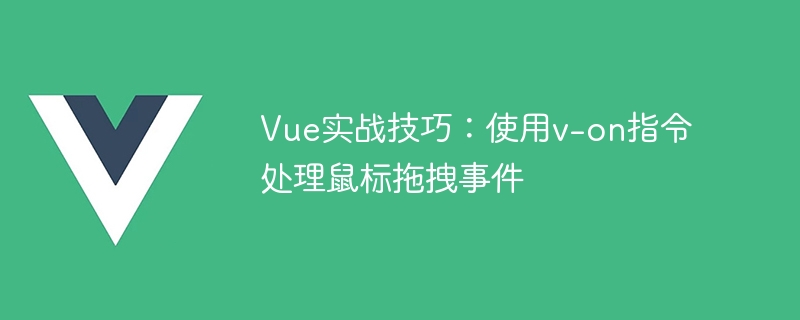Vue实战技巧:使用v-on指令处理鼠标拖拽事件

Vue实战技巧:使用v-on指令处理鼠标拖拽事件
前言:
Vue.js 是一个流行的JavaScript框架,它的简洁易用和灵活性使得它成为了众多开发者的首选。在Vue应用开发中,处理用户交互事件是必不可少的一项技能。本文将介绍如何使用Vue的v-on指令来处理鼠标拖拽事件,并提供具体的代码示例。
-
创建Vue实例:
首先,在HTML文件中引入Vue.js的库文件:<script src="https://cdn.jsdelivr.net/npm/vue"></script>
登录后复制然后,创建一个Vue实例:
<div id="app"> ... </div> <script> var app = new Vue({ el: '#app', data: { ... }, methods: { ... } }); </script>登录后复制 添加原始数据:
为了实现鼠标拖拽功能,我们需要定义一些用于控制拖拽元素位置的数据。在Vue实例的data选项中添加如下代码:data: { dragging: false, // 标记是否正在拖拽 x: 0, // 鼠标在页面上的横坐标 y: 0, // 鼠标在页面上的纵坐标 left: 0, // 拖拽元素的左侧偏移量 top: 0 // 拖拽元素的顶部偏移量 }登录后复制绑定鼠标事件:
通过v-on指令,我们可以方便地绑定DOM元素的鼠标事件。在Vue实例的methods选项中添加如下代码:methods: { handleMouseDown: function(event) { this.dragging = true; this.x = event.pageX; this.y = event.pageY; }, handleMouseMove: function(event) { if (this.dragging) { var dx = event.pageX - this.x; var dy = event.pageY - this.y; this.left += dx; this.top += dy; this.x = event.pageX; this.y = event.pageY; } }, handleMouseUp: function() { this.dragging = false; } }登录后复制代码解析:
- handleMouseDown:当鼠标按下时,设置dragging为true,并记录鼠标在页面上的位置。
- handleMouseMove:当鼠标移动时,根据鼠标位置的变化计算出元素的偏移量,并更新left和top的值。
- handleMouseUp:当鼠标松开时,设置dragging为false。
添加拖拽元素:
在HTML文件中,在合适的位置添加一个拖拽元素:<div v-on:mousedown="handleMouseDown" v-on:mousemove="handleMouseMove" v-on:mouseup="handleMouseUp" v-bind:style="{left: left + 'px', top: top + 'px'}" ></div>登录后复制代码解析:
- v-on:mousedown:绑定鼠标按下事件。
- v-on:mousemove:绑定鼠标移动事件。
- v-on:mouseup:绑定鼠标松开事件。
- v-bind:style:根据left和top的值动态设置元素的位置。
完整的代码示例如下:
<div id="app">
<div v-on:mousedown="handleMouseDown"
v-on:mousemove="handleMouseMove"
v-on:mouseup="handleMouseUp"
v-bind:style="{left: left + 'px', top: top + 'px'}"
></div>
</div>
<script>
var app = new Vue({
el: '#app',
data: {
dragging: false,
x: 0,
y: 0,
left: 0,
top: 0
},
methods: {
handleMouseDown: function(event) {
this.dragging = true;
this.x = event.pageX;
this.y = event.pageY;
},
handleMouseMove: function(event) {
if (this.dragging) {
var dx = event.pageX - this.x;
var dy = event.pageY - this.y;
this.left += dx;
this.top += dy;
this.x = event.pageX;
this.y = event.pageY;
}
},
handleMouseUp: function() {
this.dragging = false;
}
}
});
</script>总结:
通过使用Vue的v-on指令,我们可以轻松地处理鼠标拖拽事件。本文通过具体的代码示例,详细介绍了如何实现一个简单的拖拽功能。希望读者能够掌握这一实战技巧,并在自己的Vue应用中运用起来。
以上是Vue实战技巧:使用v-on指令处理鼠标拖拽事件的详细内容。更多信息请关注PHP中文网其他相关文章!

热AI工具

Undresser.AI Undress
人工智能驱动的应用程序,用于创建逼真的裸体照片

AI Clothes Remover
用于从照片中去除衣服的在线人工智能工具。

Undress AI Tool
免费脱衣服图片

Clothoff.io
AI脱衣机

AI Hentai Generator
免费生成ai无尽的。

热门文章

热工具

记事本++7.3.1
好用且免费的代码编辑器

SublimeText3汉化版
中文版,非常好用

禅工作室 13.0.1
功能强大的PHP集成开发环境

Dreamweaver CS6
视觉化网页开发工具

SublimeText3 Mac版
神级代码编辑软件(SublimeText3)

热门话题
 vue怎么给按钮添加函数
Apr 08, 2025 am 08:51 AM
vue怎么给按钮添加函数
Apr 08, 2025 am 08:51 AM
可以通过以下步骤为 Vue 按钮添加函数:将 HTML 模板中的按钮绑定到一个方法。在 Vue 实例中定义该方法并编写函数逻辑。
 vue.js怎么引用js文件
Apr 07, 2025 pm 11:27 PM
vue.js怎么引用js文件
Apr 07, 2025 pm 11:27 PM
在 Vue.js 中引用 JS 文件的方法有三种:直接使用 <script> 标签指定路径;利用 mounted() 生命周期钩子动态导入;通过 Vuex 状态管理库进行导入。
 vue中的watch怎么用
Apr 07, 2025 pm 11:36 PM
vue中的watch怎么用
Apr 07, 2025 pm 11:36 PM
Vue.js 中的 watch 选项允许开发者监听特定数据的变化。当数据发生变化时,watch 会触发一个回调函数,用于执行更新视图或其他任务。其配置选项包括 immediate,用于指定是否立即执行回调,以及 deep,用于指定是否递归监听对象或数组的更改。
 vue中怎么用bootstrap
Apr 07, 2025 pm 11:33 PM
vue中怎么用bootstrap
Apr 07, 2025 pm 11:33 PM
在 Vue.js 中使用 Bootstrap 分为五个步骤:安装 Bootstrap。在 main.js 中导入 Bootstrap。直接在模板中使用 Bootstrap 组件。可选:自定义样式。可选:使用插件。
 vue返回上一页的方法
Apr 07, 2025 pm 11:30 PM
vue返回上一页的方法
Apr 07, 2025 pm 11:30 PM
Vue.js 返回上一页有四种方法:$router.go(-1)$router.back()使用 <router-link to="/"> 组件window.history.back(),方法选择取决于场景。
 Vue 实现跑马灯/文字滚动效果
Apr 07, 2025 pm 10:51 PM
Vue 实现跑马灯/文字滚动效果
Apr 07, 2025 pm 10:51 PM
在 Vue 中实现跑马灯/文字滚动效果,可以使用 CSS 动画或第三方库。本文介绍了使用 CSS 动画的方法:创建滚动文本,用 <div> 包裹文本。定义 CSS 动画,设置 overflow: hidden、width 和 animation。定义关键帧,设置动画开始和结束时的 transform: translateX()。调整动画属性,如持续时间、滚动速度和方向。
 怎样查询vue的版本
Apr 07, 2025 pm 11:24 PM
怎样查询vue的版本
Apr 07, 2025 pm 11:24 PM
可以通过以下方法查询 Vue 版本:使用 Vue Devtools 在浏览器的控制台中查看“Vue”选项卡。使用 npm 运行“npm list -g vue”命令。在 package.json 文件的“dependencies”对象中查找 Vue 项。对于 Vue CLI 项目,运行“vue --version”命令。检查 HTML 文件中引用 Vue 文件的 <script> 标签中的版本信息。
 vue多页面开发是啥意思
Apr 07, 2025 pm 11:57 PM
vue多页面开发是啥意思
Apr 07, 2025 pm 11:57 PM
Vue 多页面开发是一种使用 Vue.js 框架构建应用程序的方法,其中应用程序被划分为独立的页面:代码维护性:将应用程序拆分为多个页面可以使代码更易于管理和维护。模块化:每个页面都可以作为独立的模块,便于重用和替换。路由简单:页面之间的导航可以通过简单的路由配置来管理。SEO 优化:每个页面都有自己的 URL,这有助于搜索引擎优化。






